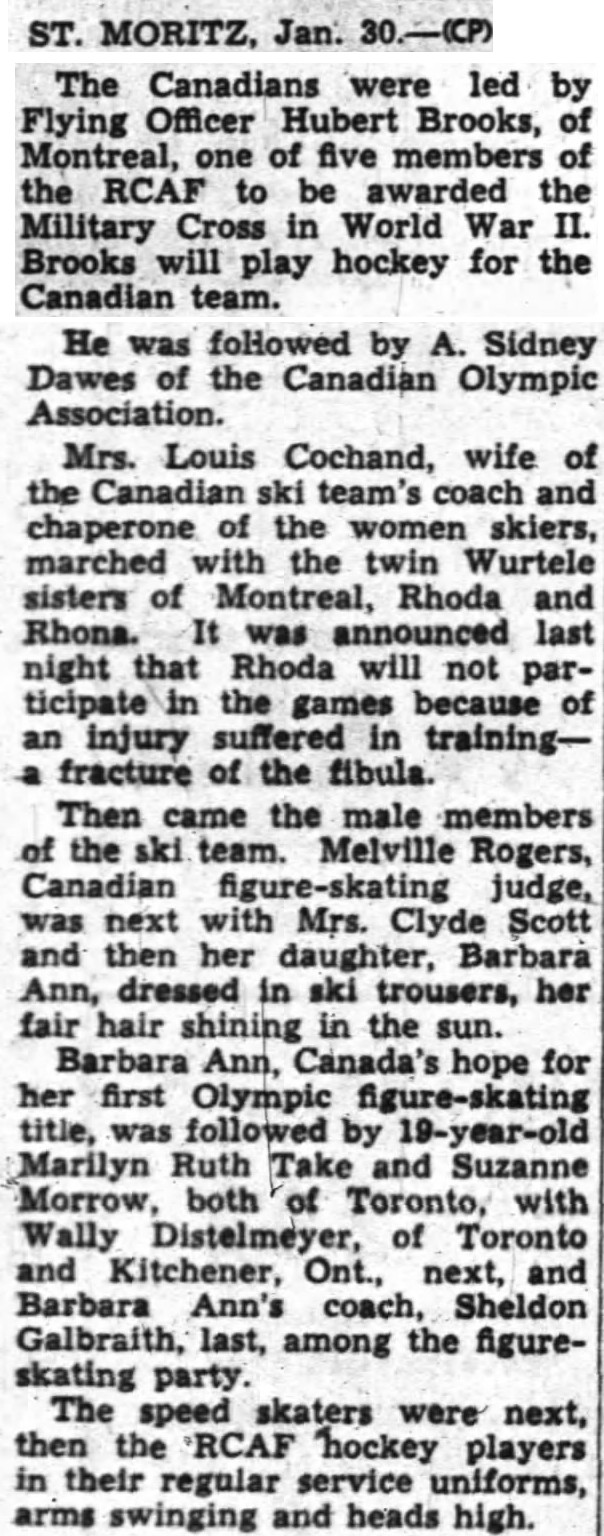 |
The Life and Times of Hubert Brooks M.C. C.D.
A Canadian Hero
|
 |
Chapter 9: R.C.A.F. Flyers At 1948 Olympics St. Moritz Switzerland
– 30th January to 8th February 1948

Section 9.2: Friday January 30, 1948: OPENING CEREMONY
The opening ceremonies for the 1948 Winter Olymic Games started at 10:15 am on January 30th along with
the initial hockey games and the first two runs of the two-man bobsled. The closing ceremonies were to be held at 4:00 pm on February 8th.
Medals for closing day events, including hockey, would be awarded at the closing ceremonies. The Olymic hockey schedule is illustrated below.
The atmosphere for me was electric. It was a general cloudy day with the temperature just below freezing. The sun
did come out for a few hours just around mid day. Thinking of the significance and tradition of the Olympic Games one could not be overcome
with the nature of the spectacle. Pressmen from all over the world were rushing around in jeeps, while visitors piled into local transportation
sleighs. Perhaps because of travel restrictions, perhaps because of budgets, Canada had 4 press personnel accredited, but we typically only saw
Jack Sullivan representing Canadian Press who covered the hockey games.
I was to be the flag bearer for Canada. I believe Sidney Dawes had selected me from amongst the
Canadian athletes – probably because my war time exploits had given me some visibility both back home in Canada and in Europe. At that time
Canada's flag was the red ensign (The flag is defaced with the Royal Arms of Canada with the maple leaves at the bottom of the shield being green.)

It seemed the entire town of 2,500 had turned out to see the procession – along with more than 10,000 visitors.
This was a reasonably significant number as currency restrictions in Europe severely limited "tourist travel". Some visitors chose
to watch them from their hotel balconies, highball in hand. The procession and atmosphere was ceremonious and pageant–like under ideal
weather conditions.
Twenty–eight nations participated. The athletes from the various nations assembled in front of the luxurious Kulm Hotel in the center of St. Moritz
for the traditional
march to the stadium over a distance equivalent to 4 city blocks. The athletes were to march three by three to the (Badrutts Park) Stad
Olympique (ice) (Olympic Stadium).
The two-mile long parade of athletes got underway at 10:15AM about 45 minutes later than scheduled.
As is common in all Olympics, Greece, birthplace of the Olympics, led the procession and the international
display of colors in the opening–day parade. Other nations followed in alphabetical order; Greece (delegation of 6), Argentina, Austria, Belgium, Canada (41 officials and athletes), Chile, Korea,
Denmark, Spain, United States (one of largest delegations with 92 men and women), Finland, France, England, Holland, Hungary, Iceland, Italy, Lybia, Liechtenstein, Norway, Poland,
Romania, Sweden, Czechoslovakia, Turkey, Yugoslavia, and finally Switzerland.
Some 915 athletes from 28 countries were in the parade.
YAAEC004: Saint–Moritz 1948: General view of the town and of the spectators on Opening
Ceremonies Day
PHOTO Courtesy: Olympic.org – Official website of the Olympic Movement

|
Canadian Contingent Marching down to Stad Olympique at Opening Ceremonies 1948 Winter Olympics
Hubert Brooks Carrying Canadian Flag
Followed by A. Sidney Dawes,(hatlesss) President of the Canadian Olympic Committee and
Thorney Pickering Assistant GM Canadian
Olympic Team
PHOTO Courtesy: Hubert Brooks Private Collection

|
R.C.A.F. Flyers Hockey Team Marching down to Stad Olympique at Opening Ceremonies 1948 Winter Olympics
Manager S/L Sandy Watson is out in Front
PHOTO Courtesy: Hubert Brooks Private Collection

|
|
R.C.A.F. Flyers Hockey Team March into Stad Olympique at Opening Ceremonies 1948 Winter Olympics
PHOTO Courtesy: Kulm St Moritz / Estate of Reg Schroeter
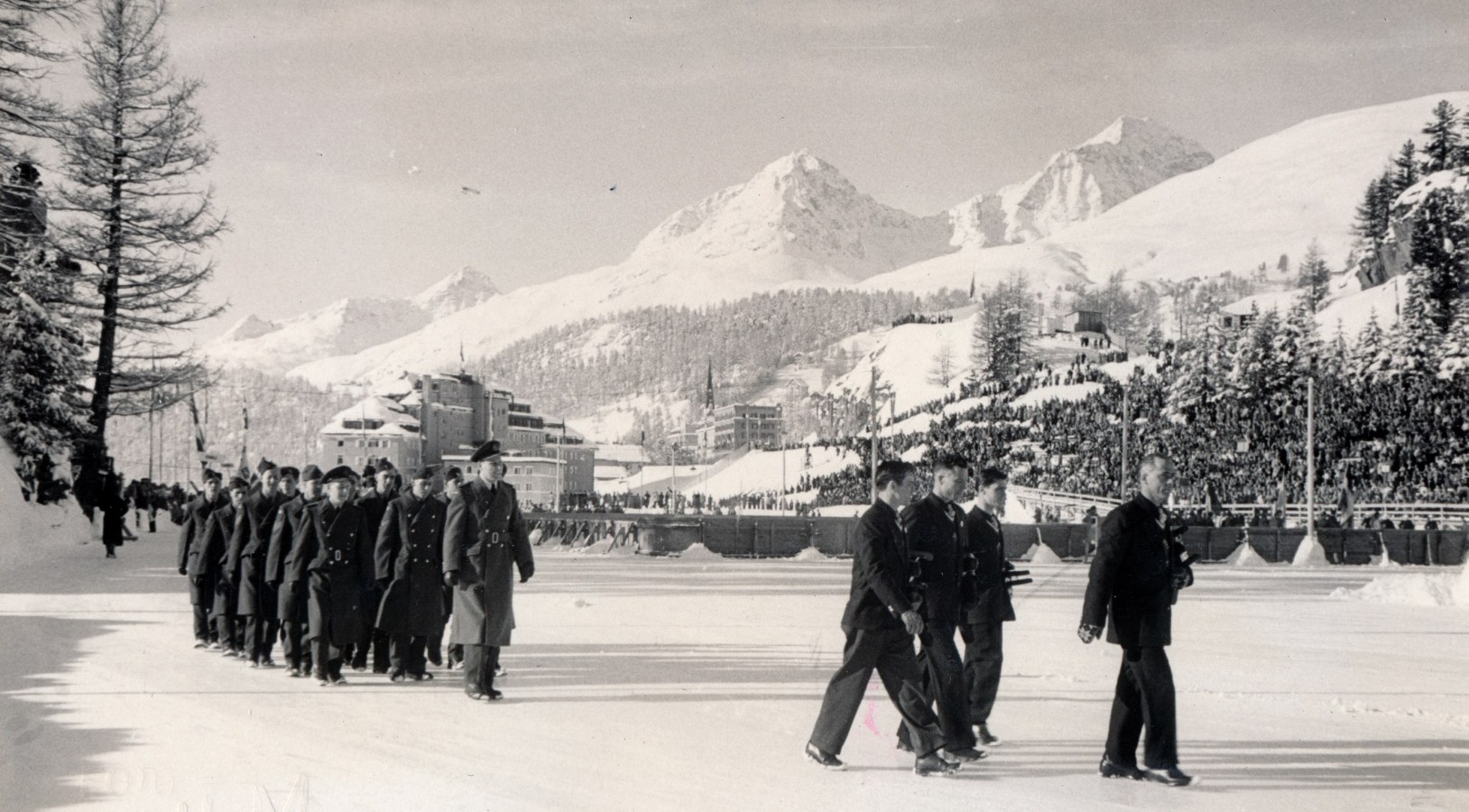
|
|
We paraded down the hill into the stadium. We drew applause as we circled the arena.
Hubert Brooks Carrying Canadian Flag Leads Canadian Olympic Contingent in March Past at Opening Ceremonies 1948 Winter Olympics
PHOTO Courtesy: Hubert Brooks Private Collection

|
R.C.A.F. Flyers Hockey Team March into Stad Olympique at Opening Ceremonies 1948 Winter Olympics
PHOTO Courtesy: Hubert Brooks Private Collection

|

PHOTO Courtesy: Montreal Gazette
Ref: 9.5

|
|
Hubert Brooks Carrying Canadian Flag Followed By Canadian Olympic Team Marches Past Grandstand
at 1948 Winter Olympics in St. Moritz Switzerland

|
|
|
Thousands in the small stadium and those standing on the face of the surrounding hills cheered and applauded.
Barbara Ann was the pin–up girl of the parade if one could judge by the applause as photographers scooted in front of her for
close–up shots.
Barbara led the Canadian woman figure skater contingent (see photo far right) with fellow Canadian skaters Marilyn Ruth Take (centre) and Suzanne Morrow (far right) immediately following.
Previously she had made the cover of TIME magazine (right).
Barbara nodded, waved and grinned.
|
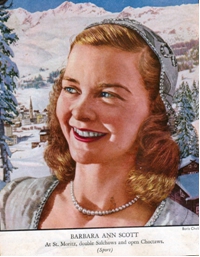
|
From left, Barbara Ann Scott, Marion Ruth Take, and Susanne Morrow, members of the Canadian Winter Olympic Figure Skating team, March in the opening parade at the ice stadium in St. Moritz, Switzerland, on January 30, 1948

|
|

Images of Poland, Switzerland, Great Britain and United States March In at 1948 Winter Olympics in St. Moritz Switzerland on January 30, 1948
Ironically enough the American AHA team did not take part in the ceremonial march–past. Avery Brundage
of the U.S. Olympic Committee won this battle and the rival U.S. Amateur Athletic Union hockey players, decked out in plush white
winter jackets, participated in the opening ceremonies – what was to be their only activity.
Opening Ceremony At 1948 Winter Olympics
The American contingent of athletes (center, in while coats) into an outdoor stadium during the opening ceremonies of the 1948 Winter Olympics
at St. Moritz, Switzerland, January 30, 1948. Jack Heaton (Skeleton, Bobsled) carried the flag for the Americans.
PHOTO Courtesy: FPG/Getty Images

|
|
St Moritz Olympics 30st January 1948:
The opening ceremony of the 1948 Winter Olympics at the Ice Stadium
in St Moritz, Switzerland, opened by Swiss
president Enrico Celio.
PHOTO Courtesy: Chris Ware/ Keystone /Getty Images
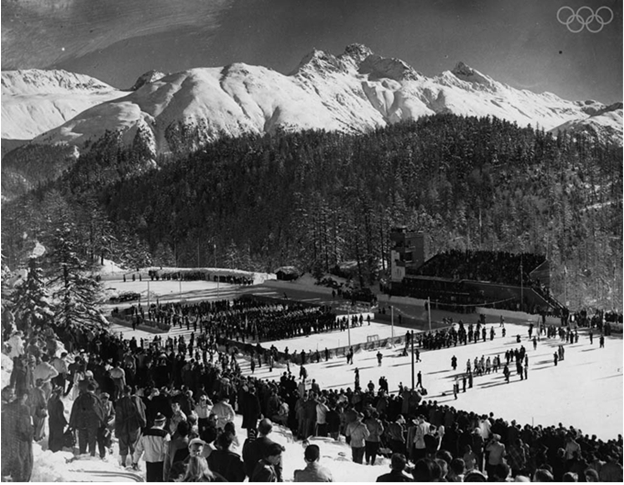
|
|
Once all of the nations had arrived and lined up in the stadium, the flag carriers then formed a procession marching
to the center Olympic podium which we encircled.
|
|
XAADG042 Saint-Moritz 1948 –The flag carriers.
(Hubert Brooks carrying the Canadian flag is third from the left in this photo.)
PHOTO Courtesy: IOC/Olympic Museum collections, Olympic.org – Official website of the Olympic Movement
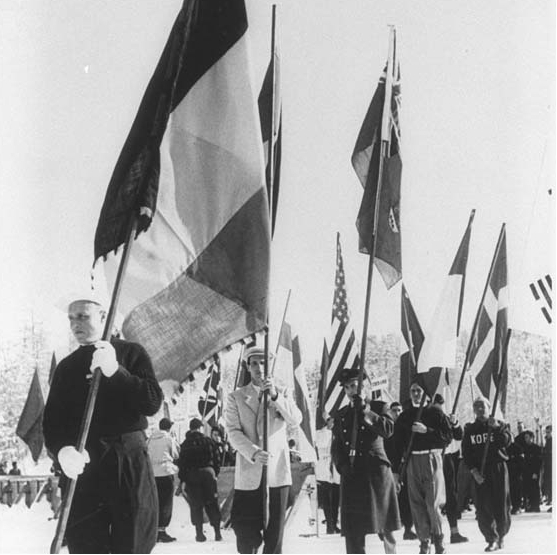
|
|
PHOTO Courtesy: IOC/Olympic Museum collections, Olympic.org – Official website of the Olympic Movement

|
PHOTO Courtesy: IOC/Olympic Museum collections, Olympic.org – Official website of the Olympic Movement

|
|
Overview of Opening Ceremony at 1948 Winter Olympics in St. Moritz

|
|
"I declare the Fifth Winter Games, as part of the modern Olympic Games, to have begun," said Enrico Celio,
President of the Swiss Olympic Federation. Celio then departed from the protocol to add: "This brilliant manifestation will be a symbol
of world peace to come."

His words may have sounded hollow in the ears of those who have sought compromise settlement for the U.S. hockey
dispute. However bright sunshine contributed to the carefree spirit of the crowd, but clearly in the ranks of officials involved in, the hockey
dispute there was no gayety – only a grim determination to prevail in the sizzling controversy as to whether the Olympic Games would have
one, two, or neither of the U. S. teams participating.
Bibi Torriani, the so called Grand Old Man of the Swiss team, who had performed for his national team 20 years earlier,
swore the Olympic oath on behalf of all competitors.
St. Moritz, 30 January 1948.
Opening ceremony of the V Olympic Winter Games:
the Swiss hockey player Richard ‘Bibi’TORRIANI taking the Olympic oath, surrounded by the flag bearers of the nations.
PHOTO Courtesy: IOC/Olympic Museum collections, Olympic.org – Official website of the Olympic Movement

|
|
Swiss Hockey Player Bibi Torriani Recites Olympic Oath
at 1948 Winter Olympics

|
|

|
Lighting of the Olympic flame in the ice stadium at St. Mortiz, Switzerland
PHOTO Courtesy: IOC/Olympic Museum collections, Olympic.org – Official website of the Olympic Movement

|
|
Olympic Flag Being Raised at 1948 Winter Olympics in St. Moritz

|
|
After the ceremony, we were directed to position each of the country flags in a bank of snow at one end of the
stadium – a far cry from the formality of today's Olympic Games.

PHOTO Courtesy: IOC/Olympic Museum collections, Olympic.org – Official website of the Olympic Movement

|
Following the parade, the team was brought back to our hotel in "cutters" - horse drawn sleds.
For some "iron curtain" countries, like Rumania and Yugoslavia, it became clear that there was a deeper
and grimmer game afoot. For some, competition had become almost a matter of life & death; some athletes were nervous about going back home
if they didn't perform up to snuff. Soviet Russia sent no competitors, only a dour vigilante squad of ten observers.
Most of the ice hockey games were held at the Suvretta and Kulm (Palace) stadiums in St. Moritz. The Stade Olympique
(Olympic Stadium) hosted the opening and closing ceremonies. The stadium was also used for speed skating, the figure skating competition and
the medal games for ice hockey.
The Life and Times of Hubert Brooks M.C. C.D.
Copyright © 2011, 2012, 2013, 2014, 2015, 2016, 2017, 2018, 2019, 2020, 2021, 2022, 2023, 2024 Ralf Brooks, All Rights Reserved
|








